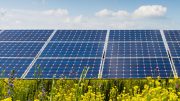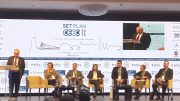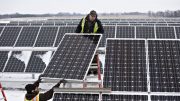![The EU made promises to curb global warming at the UN Climate Change Conference. It can only keep them by boosting renewable energy in the bloc. [James Crisp] The EU made promises to curb global warming at the UN Climate Change Conference. It can only keep them by boosting renewable energy in the bloc. [James Crisp]](http://beta.onlynaturalenergy.com/wp-content/uploads/2016/11/23651702316_14b2c33bc0_z-2-1-300x169.jpg)
The EU made promises to curb global warming at the UN Climate Change Conference. It can only keep them by boosting renewable energy in the bloc. [James Crisp]
The Paris Agreement on climate change is an international commitment that can only be kept by the European Union if effective, consistent policy drives the shift to a low-carbon economy through action which boosts renewable energy such as solar power.
Ratified by the EU in early October, the agreement is a landmark pact to keep global warming to less than two degrees above pre-industrial levels.
The task is enormous. World leaders made promises to curb their emissions in the run-up to the UN Climate Change Conference in Paris. But these Intended Nationally Determined Contributions will only cap global warming at 3.7 degrees.
Efforts and ambition will have to be further stepped up by the EU, and other major polluters such as the US and China. The Paris Agreement enters into force on 7 November.
Europe is already the most solarised region in the world, with almost 100GW of installed capacity. In 2015, 8.1 GW of solar power was added to the grid, a 15% increase on the 7GW in 2014. But that boost was the first increase since 2010-2011, according to trade association SolarPower Europe.
This positive trend needs to be accelerated if the EU is to turn away from an economy based on fossil fuels and extraction to embrace a low carbon, sustainable future.
Trade barriers
One barrier to the sector’s expansion, according to leading industry bodies and environmental NGOs, is the ongoing trade dispute between the EU and China over solar cells and modules.
The European Commission placed punitive tariffs – extra duties to be paid by the importer – on Chinese solar cells and modules in 2013. The measures are currently being reviewed with a decision expected in March 2017.
The anti-dumping measures were conceived as a way of guaranteeing fair competition with European manufacturers. It remains the largest trade dispute between the EU and China.
Supporters argue that the measures are necessary because China was selling the cells and modules at a value below its normal price on the domestic market.
There is also a perception that the EU had done most of the expensive ‘heavy lifting’ on solar products, only to miss out on the profits after being muscled out by China.
But opponents of the anti-dumping measures argue that it is time to draw a line under the row, that they have stunted growth in European solar, and that the bloc stands no chance of hitting its climate objective with them in place.
The tariffs make solar panels more expensive and are slowing the deployment of solar across the EU.
But how does solar fit into the EU policy picture, and how it can answer some of the questions faced by the EU?
Climate policy and renewables
A suite of policies at European level are being brought to bear to cut emissions across an economy that is still dominated by an overwhelming dependence on polluting fossil fuels.
Renewable energy is a vital piece in this jigsaw. Technologies such as wind and solar generate electricity without carbon emissions, unlike coal or gas.
This clean energy can be used to drive down emissions across sectors, including transport, the one sector in the EU where emissions can continue to rise, as it becomes more electrified in the future.
The Commission’s flagship Energy Union plan has twin goals; to fight climate change and reduce the bloc’s dependence on energy imports. Renewable energy provides part of the answer to both of those questions.
It foresees a connected EU energy system, where shortages in one area can be made up by a surplus elsewhere. Policymakers want to better connect renewables into this system, and incentivise homeowners and businesses to generate their own power, through, for example, solar panels on their roofs.
The EU imports more than half of its energy every year. The crisis in Ukraine brutally exposed just how addicted the bloc was to Russian gas, giving the project political impetus.
Commission President Jean-Claude Juncker has vowed to make the EU “the world leader in renewables”.
The EU has set itself the target of boosting the share of renewables by at least 27% by 2030, compared to 1990 levels.
That goal is one of three climate and energy targets backed by EU leaders before the Paris Agreement. The Commission is expected to translate the targets into EU legislation in early December.
The executive also plans to publish a paper on the design of the EU’s electricity market. It is expected to push for greater integration of renewables.
These policy imperatives are positive market signals for the solar industry. In an ideal world, such signals should convince investors to reach into their pockets.
This financial backing could be further incentivised at EU level through judicious use of the European Investment Bank-helmed Juncker Plan, which offers risk guarantees on project investment to get them off the ground.
Investors need certainty but are skittish when it comes to renewables because they have been burnt by national policymakers in the past.
In Spain and the UK, the governments retroactively withdrew guaranteed support schemes for wind and solar.
Such subsidies, long-established in fossil fuel industries, were important in getting the technology off the ground. The solar industry is now transitioning to a market based model, after being let down at national level.
Economy and employment
There is the potential to give the economy a boost and cut Europe’s stubbornly high levels of unemployment, as clean jobs are created in the solar industry.
European innovation in renewables can create employment once the technology is brought to the market and rolled out at scale.
The Commission has initiatives in the pipeline to boosts research and development but without creating the right market conditions to roll out such innovation, the EU could miss out on the benefits.
The construction industry is a bellwether for the economy. The installation of solar panels on homes, if supported by consumer education, training, and forward-thinking financial services, will provide local employment.
Most companies working in construction are SMEs, identified by policymakers as drivers of the economy. The European construction industry is keen to harness the shift to the low carbon economy to create a new generation of SMEs.
Antidumping and protectionism
This week’s Special Report will examine the issues surrounding the Commission’s review of the anti-dumping measures. The Commission will have to weigh up the competing claims and political pressures for and against the duties, and whether they can meet their policy objectives with them in place.
The antidumping regulation is EU law. Any Commission decision will have to respect that legal framework but officials do have flexibility if they decide the wider interests of the Union outweigh the arguments for the trade defence measures.
Groups such as Greenpeace and Climate Action Network, and trade association SolarPowerEurope, are adamant that they do.
Meanwhile the political mood music, in Europe and globally, is increasingly protectionist.
The Commission is working on new trade defence instruments, driven by calls to protect the European steel industry from Chinese competition.
The executive is also investigating the Chinese solar industry after complaints that Chinese companies were dodging the duties by exporting through Taiwan and Malaysia.
There is public anxiety about the EU’s mooted free trade agreements with Canada and the US, CETA and TTIP.
There are concerns that such deals could drive down environmental protection standards. Some politicians are opposed to the removal of tariffs at a time when European industries are vulnerable to the pressures of globalisation.
But the Commission must be aware that without greater deployment of solar in Europe, the EU will not meet the climate commitment it has ratified with such celebration and fanfare.
Oct. 17,2016
By James Crisp
Originally published by Euractiv






Be the first to comment on "Europe’s climate policy goals hinge on renewables, solar power"